April 4, 2008
Air Date: April 4, 2008
FULL SHOW
SEGMENTS
Delivering on Energy and the Environment
/ Jeff YoungView the page for this story
Would Hillary Clinton have the political will to deliver on her ambitious plans for energy and the environment? Living on Earth's Jeff Young finds the answer depends on which part of the Clinton record you look at. (06:15)
Dangerous Assumptions
View the page for this story
An article in the latest issue of the journal “Nature” asserts that the Intergovernmental Panel on Climate Change has seriously underestimated the technological solutions necessary for the stabilization of the climate. The commentary is titled “Dangerous Assmptions” and it’s co-authored by Senior Scientist Tom Wigley of the National Center for Atmospheric Research. Dr. Wigley talks with host Bruce Gellerman. (05:30)
Shared Space
View the page for this story
In two and a half years the United States will decommission the three remaining shuttles capable of taking astronauts to the International Space Station. The only option after that will be to hitch a ride on a Russian shuttle. Neil DeGrasse Tyson, director of the Hayden Planetarium, tells host Bruce Gellerman that such an international collaboration may be just what we need in the space program. (07:30)
Sleek and Cheap
/ Prachi Patel-PreddView the page for this story
The eggbeater design of the vertical axis wind turbine is nothing new but it may be the wave of the future. A small company in Nevada is testing the efficiency of their vertical turbines and, as Spectrum Radio's Prachi Patel-Predd reports, if they pass muster, the relatively inexpensive windmills may soon be on the market for homeowners. (05:00)
A Windmill for Your Pocket
View the page for this story
The sun and wind can power your portable gadgets and keep you connected. Host Bruce Gellerman talks with designer Arthur Huang about his creation, the HYmini-- a solar panel and windmill that fit in your pocket. (04:00)
To Catch a Trash Thief
/ Joe RichmanView the page for this story
In the mid 1990s, a national paper shortage caused the price of used newsprint to soar. In New York City, thieves searched the sidewalks for recycled newspaper and the Sanitation Department sent out a special patrol to stop them. In honor of Earth Day, Living on Earth rebroadcasts its 1995 award-winning report on New York City's “Black Market in Newsprint” by producer Joe Richman. Host Bruce Gellerman then talks with NYC Sanitation Commissioner John Doherty to update the story and finds out that old metal is now the hot commodity. (10:30)
Amazon Expeditions
View the page for this story
Ecologist Paul Colinvaux spent forty years traveling along the equator to find out what the region looked like during the Ice Age. Colinvaux searched for ancient lakes and collected pollen and mud from them to find clues. Paul Coinvaux chronicles his journeys in the book “Amazon Expeditions, My Quest for the Ice Age Equator” and talks with host Bruce Gellerman. (06:30)
Show Credits and Funders
Show Transcript
HOST: Bruce Gellerman
GUESTS: Tom Wigley, Neil deGrasse Tyson, Arthur Huang, John Doherty, Paul Colinvaux
REPORTERS: Jeff Young, Prachi Patel-Predd
[THEME]
GELLERMAN: From Public Radio International, this is Living on Earth.
[THEME]
GELLERMAN: I’m Bruce Gellerman. Coming up: power politics -- testing Hillary Clinton’s mettle on energy issues.
HITT: Her experience, her track record would certainly indicate that she has all the qualities that it would take to stand up to big powerful energy interests. However, her actions on the ground so far have not been as promising.
GELLERMAN: Also, slow but steady wins the space race. In fact, Americans will soon have to hitch rides on Russian rockets.
TYSON: The fact that we are dependent on another nation’s resources, that doesn’t scare me. In fact, I think we should celebrate that interdependence because that may be what’s required to fully realize our future in space.
GELLERMAN: Space travel without the space shuttle.
And, digging deep into ancient lake mud to discover clues about climate change. We'll have these stories and more, this week on Living on Earth. Stick around!
ANNOUNCER: Support for Living on Earth comes from the National Science Foundation, and Stonyfield Farm.
[NEWSCAST]
Delivering on Energy and the Environment
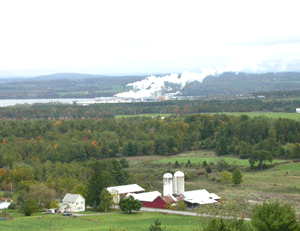
International Paper's test burn of waste tires drew protests from downwind residents but the project got support from Senator Clinton.(Photo: Glenn Estus)
[RETURN THEME]
GELLERMAN: From the Jennifer and Ted Stanley Studios in Somerville, Massachusetts, this is Living on Earth. I’m Bruce Gellerman, in for Steve Curwood.
Senator Hillary Clinton says she has big plans for tackling global warming and our addiction to fossil fuels. As part of our continuing coverage of green issues in the race for the White House, Living on Earth¹s Jeff Young investigates the Clinton record when it comes to taking on the energy industry.
YOUNG: Early in her run for president, Senator Hillary Clinton told labor and environmental leaders about a cornerstone of her energy plan. Oil companies were going to have to become cleaner energy companies.
CLINTON: Well, we have to tell the oil companies to play or pay. Either invest more of their windfall profits in alternative energy development, or pay into a strategic energy fund to get this country substantially off oil, and on to cleaner and more secure forms of energy.
YOUNG: Well, that went over well with the environmentalists. But about a year later, Clinton faced arguably the political battle of her life in a must-win primary race in Texas, a place where they’re rather fond of drilling oil. But Clinton campaign advisor Catherine Brown says Clinton did not back away from her big oil challenge.

Senator Hillary Clinton at the Presidential Forum on Global Warming and America's Energy Future. Clinton said she'll force big oil companies to spend more on clean energy, even as she campaigned deep in the heart of oil-rich Texas.(Photo: Laura Kleinhenz)
YOUNG: Brown says that’s the gutsy leadership Clinton also showed on the Senate’s environment committee. She worked to lower diesel emissions, raise fuel economy, and fought against efforts to weaken environmental enforcement.
BROWN: I think Senator Clinton has an extremely long, strong record on environmental issues, and a very clear vision of where she wants to take our country.
YOUNG: But despite that record, grass roots activists in New England and Appalachia say Clinton took the wrong side in their energy and environment issues. First, New England: three years ago, International Paper’s mill in Ticonderoga, New York, wanted to lower its fuel costs by burning waste tires to fire its boilers. The mill is an important employer in upstate New York. But downwind in Middlebury, Vermont, Joanna Colwell wondered what burning tires might mean for her newborn child.
COLWELL: Almost every kind of pollutant that they can measure is increased, you know, from heavy metals to dioxin, and these are all -- have a very, very bad impact on children's developing brains.
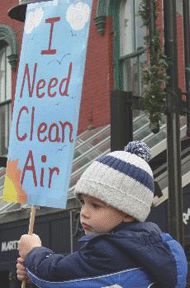
A boy protests the International Paper Company's tire burn in Ticonderoga in 2006.(Photo: Thomas Ford-Hutchinson, Courtesy of the Vermont Cynic)
COLWELL: I remember when I saw the letter that she wrote I just thought, ‘isn¹t this the woman who said “it takes a village to raise a child”?’
YOUNG: International Paper ran its test, but it was halted after just a few days because the pollution exceeded the company’s air permit. Brown, with the Clinton campaign, dismisses it all as a minor incident.
BROWN: This is a little silly. Senator Clinton supported a permit for a test. It was certainly not anything bigger than that.
COLWELL: They're testing on us! It's not okay; we are not guinea pigs. And it felt really cynical to me that she just wanted those votes in upstate New York.
YOUNG: In Appalachia, activists fighting damaging mining practices also say they see a gap between Clinton’s rhetoric and record. Here was Clinton in a speech to environmentalists last year:
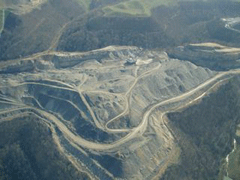
Senator Clinton said she won’t take a position on mountaintop removal mining because of "the conflict between economic and environmental tradeoffs."(Photo: Jeff Young)
YOUNG: But that’s not quite the message Senator Clinton had when she traveled to coal country last month. West Virginia Public Radio asked Clinton about mountaintop removal -- the mining practice that flattens hilltops and dumps waste in streams.
CLINTON: I think it’s a difficult question because of the conflict between the economic and environmental tradeoffs that you have here.
YOUNG: Clinton said she has no position on mountaintop removal. She emphasized her support for the continued use of coal, and said the government should help pay for technology to capture coal’s greenhouse gases and convert coal to a liquid fuel for transportation.
CLINTON: It's imperative that we do everything we can to get to a technology that enables us to use clean coal that supports the subsidies for coal to liquids projects that meet that environmental standard that I think we can set.
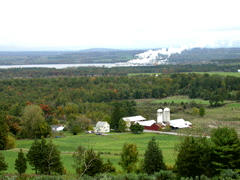
International Paper's test burn of waste tires drew protests from downwind residents but the project got support from Senator Clinton.(Photo: Glenn Estus)
HITT: Well, Senator Clinton's intelligence, her experience, her track record would certainly indicate that she has all the qualities that it would take to stand up to big, powerful energy interests. However, her actions on the ground so far in West Virginia and Kentucky have not been as promising, and it definitely calls into question whether or not she would really be willing to stand up to those industries if she was the next president of the United States.
YOUNG: Campaign advisor Brown says Clinton is taking a realistic view of an important energy source.
BROWN: You know, she understands the challenge that we face with coal, but coal right now represents half of our energy mix, and Senator Clinton isn’t under the illusion that in one day we can move to fueling our economy entirely through alternative and renewable fuels.
YOUNG: Brown says look at the big picture, and you see a senator who’s earned a 90 percent positive rating from the League of Conservation Voters. Residents like Colwell and Hitt say look at the details and you see someone who chose political convenience over principle. Either way you see it, it reflects something Clinton has often said during this campaign: that she may be the most famous person you don’t really know. For Living on Earth, I’m Jeff Young in Washington.
Related links:
- League of Conservation Voters scorecard on Senator Clinton
- Read the letter Senator Clinton wrote supporting the International Paper test tire burn
- Check our Living on Earth's coverage of Barack Obama's environmental record here
- Living on Earth explores the environment and the presidential elections in "A Greener White House?”
- Learn more about mountaintop removal mining from Living on Earth's previous coverage
Dangerous Assumptions
GELLERMAN: “Dangerous Assumptions” is the ominous-sounding title of a commentary in the latest edition of the British journal Nature. The authors of the commentary charge that the Nobel Peace Prize-winning organization, the IPCC, has been using incorrect assumptions about climate change and seriously underestimates what it will take to save the Earth from catastrophe. Tom Wigley is one of the authors of “Dangerous Assumptions.” He’s a senior scientist at the National Center for Atmospheric Research in Boulder Colorado. Professor, thanks for joining me.
WIGLEY: Thanks for having me. Good to talk to you, Bruce.
GELLERMAN: This is a pretty serious charge. What specifically are the dangerous assumptions the IPCC has been making?
WIGLEY: The assumptions are more in the presentation of information regarding what we might have to do to reduce the magnitude of global warming in the future. What IPCC has done is they haven’t given the full picture of what those assumptions might be.
GELLERMAN: I was surprised to read in your article that the assumption that the IPCC makes is that about three-quarters of the carbon in the atmosphere is just going to simply, spontaneously, automatically disappear.
WIGLEY: Yes, that’s right. In the absence of climate policy, they're expecting large changes in progression towards using what are called carbon neutral sources of energy. IPCC essentially assumes that a lot of those things are going to happen just spontaneously. That’s the key word.
GELLERMAN: Well, how does carbon just spontaneously, automatically disappear, anyhow?
WIGLEY: Well, in the past, energy efficiency has improved. If you look at the records over the last number of decades, even over the last century, in terms of the emissions of carbon dioxide per unit of energy, we’re improving the way we produce energy. But what is a little alarming is that if you look at just the last five to ten years, those changes have gone in the other direction. Now, if you make assumptions that the changes that occurred up to say the year 2000 are going to continue in the future, and you look at what’s happened over the last five years or so, that change towards greater efficiency has not continued.
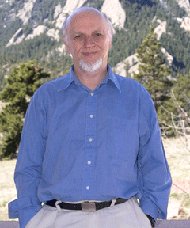
Scientist Tom Wigley co-authored a commentary criticizing the IPCC in the journal "Nature."(Photo: Carlye Calvin, Courtesy of UCAR)
WIGLEY: Essentially, China and India are using twentieth-century technology in the twenty-first century. Now, you can’t blame China and India for doing this because that is the cost-effective way of doing things. But if you just project ahead what’s going on now in China and India then the emissions from those countries are going to continue to increase for many decades.
GELLERMAN: Well, what about targeting limits on carbon dioxide for example? That’s what governments have been doing. That’s what the Kyoto Protocol calls for. Will that clear up the problem?
WIGLEY: Well, the Kyoto Protocol assumes that there will be a succession of protocols that become increasingly stringent as the decades go by. Well, we’re having trouble even abiding by the Kyoto Protocol. So the prospects for further and stronger protocols in the future look rather bleak at the moment. Now, part of the problem is that the Kyoto Protocol deals with a concept called targets and timetables. It essentially says, we want to reduce the emissions of carbon dioxide by a certain amount globally by a certain time. Now, that’s all very well, except that it doesn’t really tell us how we’re going to do it. What we suggest is that there needs to be more emphasis on developing the appropriate technology, the appropriate carbon-neutral technology to reduce emissions. So, don’t just tell us where to go, tell us how to get there and legislate how to get there.
GELLERMAN: What form of legislation would you suggest?
WIGLEY: What we need is policies that put a large amount of money into developing appropriate, carbon-neutral technologies, be it renewable energy, methods for storing carbon dioxide in the ground and so on. There is money being used and put towards developing those sorts of technologies, but it’s too small by orders of magnitude. We need to be putting, you know, ten to 100 times more money into developing appropriate technologies to reduce the magnitude of global warming.
GELLERMAN: So, you’re talking about something the size and scale of the Manhattan Project?
WIGLEY: Yes, indeed. That’s exactly the term that’s been used in a number of papers in the past.
GELLERMAN: Well, why not just leave it up to industry? I mean, if there’s gold or money to be made in them thar hills, you know, let them go out and develop the technology.
WIGLEY: Yes, industry is very good at developing the technology, but if you look at the major innovations that have occurred over the twentieth century, the initiation, the innovation in almost all cases comes from government research spending. Once the concepts are out there, then industry comes in and makes a buck out of it. But they’re not good at starting the ball rolling.
GELLERMAN: But government money doesn’t grow on trees -- it comes out of my pocket.
WIGLEY: Yes indeed, but then, in the long run, you, your children, your grandchildren, will benefit by having a planet that’s not upset by what could be catastrophic changes in the climate or very large increases in sea level and so on.
GELLERMAN: Tom Wigley is a senior scientist at the National Center for Atmospheric Research in Boulder, Colorado, and co-author of the article now appearing in the British journal Nature: “Dangerous Assumptions.” Thank you very much.
WIGLEY: Thank you, it’s been a pleasure.
Related links:
- National Center for Atmospheric Research
- Intergovernmental Panel on Climate Change
- Click here to read the article "Dangerous Assumptions" in the journal Nature
[MUSIC: Various Artists “It’s About That Time” from Miles From India (Times Square Records 2008)]
GELLERMAN: Coming up, charging your cell phone with a pocket-sized windmill. Stay tuned to Living on Earth.
Shared Space
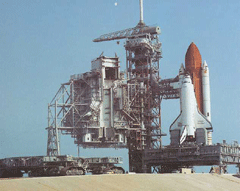
By 2010 shuttle launches like this in the United States will be put on hold until the next generation of shuttles are up and running in 2015. (Photo: NASA)
GELLERMAN: It’s Living on Earth. I’m Bruce Gellerman. America’s fleet of re-usable space shuttles has been serving the nation for over thirty years now, sending astronauts into low Earth orbit. But in 2010, the remaining U.S. shuttles will make their final landings. The aging fleet is being retired, and it won’t be until 2015 that new capsules and rockets will be ready to send Americans back into space. It’s a five-year missile gap that has some worried that we’ll be dependent on other nations to get us into orbit. But not Neil deGrasse Tyson. He’s the director of the Hayden Planetarium in New York City and our go-to guy on all things space.
TYSON: During this gap, that’s right, we’re going to have to be renting or buying a seat on the Russian Soyus space capsule. We’ve done it before, by the way, but now we’ll have to do it. There will be no other choices to get us to our own space station.
GELLERMAN: Is there a danger in being dependent upon the Russians to provide, you know, the transport to space?

By September 30, 2010 the only way to get to space will be aboard Russian shuttles like the Soyus. (Photo: NASA)
GELLERMAN: What happens, though, if there’s an international crisis? We go toe to toe with the Russians and we don’t get our ride into space.
TYSON: That would be bad, that’s correct. And we could be stranding astronauts up there on the space station. I’d like to think, however -- this may be a little either politically naïve or sort of wishful thinking -- I’d like to think that when you have collaborations on that level that it precludes political conflict because you say to yourselves, 'we are together up there in space, that overrides everything.' It’s been said that space is not about flag waving because, of course, a flag in space doesn’t wave where there is no air….

Neil deGrasse Tyson is director of New York's Hayden Planetarium (Courtesy of Patrick Queen, reprinted with permission of Prometheus Books)
TYSON: …so that might be a lesson for all of us.
GELLERMAN: I remember they used to be talking about the missile gap, back in the sixties. It seems like we’ve got a missile gap and we’re losing the space race then.
TYSON: I don’t think about it just that way because you have to ask, 'well what’s going on here in that five year gap?' What we’re attempting to do is create a next generation launch vehicle that will take our astronauts not only to low Earth orbit, which is where the space shuttle had been going and the space station is, but beyond Earth orbit to the moon, Mars and beyond. And so I don’t think of it as losing a space race, although we will be sort of underserved over that five year period.
GELLERMAN: Well, what about the next generation of manned vehicles for the United States? What is that going to look like?
TYSON: Well, it won’t look like the shuttle, because it doesn’t have the same requirements as the shuttle. This new suite of launch vehicles, which will get to Earth orbit and beyond, have separated the astronauts from the cargo. So, you send the cargo up first and then you send the astronauts up next and they re-dock with the cargo. And in that way you don’t need the same rating on the launch vehicle for the cargo that you would require for the protection of the astronauts. It’s not only safer, it’s more efficient because you can tune the vehicles for exactly their purpose.
GELLERMAN: You know, what’s fascinating is that in my little cell phone that I have in my hand right here, I’ve got more computing power than they had to land the Apollo on the moon.
TYSON: Yeah, it wasn’t quite as bad as like the Flintstones where they were running their feet along the ground.
GELLERMAN: Yabba dabba doo!
TYSON: But it was mostly mechanical operations, yes. And there was some computing power. But that ought to tell you what is possible when we equipped these spacecraft with modern computing and modern hardware and software. So, I have very high ambitions for what our future in space can bring. And by the way, people talk, 'well, why are we spending billions up there when we could be spending it down here?' And then you realize that when we spent billions up there it inspired an entire generation of Americans to become scientists and engineers, which enabled our entire technological revolution that we now all take for granted. It has an effect on the ambitions of an entire nation.
GELLERMAN: There are a number of private companies which have been investigating and investing and experimenting with manned vehicles. How far along are they?

By 2015 the next generation of space shuttles, The Constellation, are expected to take human beings to lower earth orbit, the moon, and even mars. (Photo: NASA)
GELLERMAN: Show me the money.
TYSON: Show me the money, and we don’t remember it that way but because we romanticize the act. But, in fact, we’ve know for a long time that prize money stimulates innovation and creativity. The moment you get the capital markets involved, then you stimulate innovation in ways that would not normally happen in a government-funded project. And when you do so, the hope is that you can get the price of going to space down to something that maybe people can afford that might have otherwise just taken a family trip to Alaska. You get it down into sort of the vacation budget. Take a moon tour or a tour of the hills and valleys of Mars.
GELLERMAN: Well, that, of course, was some of the vision of famous science fiction writer Arthur Clarke who recently died. And his concept of the space elevator, this idea that you could tether, well, basically, have an elevator shaft going to orbit.

By 2010 shuttle launches like this in the United States will be put on hold until the next generation of shuttles are up and running in 2015. (Photo: NASA)
GELLERMAN: Next stop women’s lingerie, toys, men’s wear, the moon.
TYSON: [laughing] There you go. And plus, there’s a friend of mine who’s in the industry who composes music and she composed a CD called Space Elevator Music. Because we’ve got elevator music in buildings. You might as well have one as you’re going into space. So, I look forward to that one being used.
GELLERMAN: Well, Dr. Tyson, it’s always a pleasure. TYSON: Well, thanks for having me.
GELLERMAN: Dr. Neil de Grasse Tyson is director of the Hayden Planetarium in New York City and author of the book "Death by Black Hole and Other Cosmic Quandaries."
Related links:
- Neil deGrasse Tyson’s website
- Hayden Planetarium
- NASA on the Shuttle and Space Station
[MUSIC: Elaine Walker “Red Dreams” from Space Elevator Music (Zia Music 2001)]
Sleek and Cheap
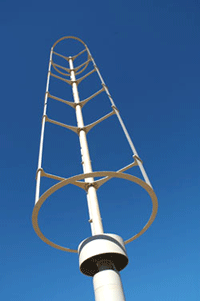
GELLERMAN: The wind power industry is picking up energy in the United States. Last year, we installed enough wind generators to power one and a half million American homes. Most of that comes from large wind farms. Less than one percent is generated by small wind turbines that you can find in backyards, farms -- even on the roofs of buildings. The problem with small wind generators is that they cost big money. But now, a Nevada company has come out with a cheaper, more efficient model that updates an old design. Spectrum Radio’s Prachi Patel-Predd has our story.
[WIND TURBINE WHIRRING]
PATEL-PREDD: On a field in Spanish Fork, Utah, about 50 miles south of Salt Lake City, a wind turbine spins furiously. If you’re picturing something that looks like a propeller, think again. This silver turbine looks more like a tall and slender egg-beater. It has three long, vertical blades that spin around a shaft. It’s 30 feet tall and four feet wide.
[WIND TURBINE WHIRRING]
PATEL-PREDD: The concept isn’t new. Vertical axis turbines have been around since the late nineteen-twenties. But they never took off like the popular three-blade propeller-type turbines because they weren’t very efficient. Now, they’re making a comeback because of better materials and designs...and a push for clean energy. Trudy Forsythe is a researcher with the Department of Energy’s National Wind Technology Center.
FORSYTHE: As the U.S. market expands because of incentive programs that exist in states or in different utility sectors more and more people are interested in designing the turbine of the future, many of them are convinced that a vertical axis turbine is the answer to that.
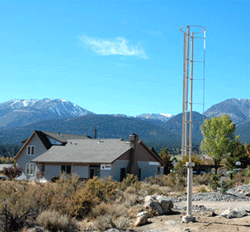
(Courtesy of Mariah Power)
HESS: With a 20-year life, it gives you an average cost of electricity of about 12.4 cents per kilowatt-hour, which is the same as the average cost of power from utilities across the United States today.
PATEL PREDD: That price is for average wind speeds of 12 miles per hour. Many other small turbines can compete with utility prices. But Mariah’s is the first vertical axis design that is competitive with utilities. In fact, the last American company that tried to sell electricity from vertical axis turbines went bankrupt in 1997. So Hess is taking a gamble, one that he thinks might pay off.
HESS: We have about 2,000 units that have already been reserved by people and ordered, so to speak.
PATEL PREDD: Hess believes vertical-axis designs are better for backyards than horizontal-axis trubines. He says they’re quieter, don’t take up much space, and are safer for bats and birds because they work at lower speeds. These pluses have been overshadowed in the past for several reasons, says energy consultant Mick Sagrillo.

Courtesy of Mariah Power
PATEL PREDD: These are the reasons why most turbine makers are pursuing traditional propeller type designs. But newer materials and designs have addressed past problems. Turbine blades are typically made of steel and aluminum alloys, which add weight. Mariah used light and strong aircraft-grade aluminum. And they've spent three years tweaking their design to get one that captures as much energy from wind as possible. First, they designed a generator that is 98 percent efficient. Then they developed a turbine shape that drives a generator, even at low wind speeds. Field tests in Utah and at the National Wind Technology Center will tell whether the technology works as well as Mariah claims it does. Mick Sagrillo says Mariah is the only vertical axis turbine manufacturer doing such testing. For now, their tests have won him over.
SAGRILLO: They are going through the effort and the expense and the time that’s involved in actually taking a look at the turbine, having an independent evaluator in an engineering firm help them with the development and doing the testing. And for that reason alone, I think they’re worth consideration.
PATEL PREDD: Mariah is expecting final results from the Utah tests any time now. If all goes well, the turbine might be ready to go up in your backyard before this summer. For Living on Earth, I’m Prachi Patel-Predd.
GELLERMAN: Our story on vertical wind turbines comes to us courtesy of Spectrum Radio, the broadcast edition of IEEE Spectrum, the magazine of technology insiders.
Related links:
- Mariah Power’s website
- National Wind Technology Center
- IEEE Spectrum Radio
A Windmill for Your Pocket
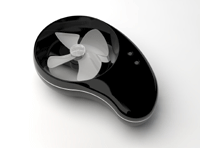
The five-inch Hymini collects wind and solar energy that feeds portable devices like cell phones.(Courtesy of Miniwiz)
GELLERMAN: Well, from an egg-beater turbine in your backyard to a windmill in your pocket.
Maybe your kitchen’s like mine. On the counter is a tangle of wires plugged into my digital devices: my cell phones, mp3 players, pdas, cameras. You know, the usual. And per usual I often forget to plug them in. So when I need them most they’re dead as digital doornails. But now there’s a device that promises to keep you charged in an environmentally sustainable way. It’s a windmill and solar collector that fits in your pocket. It’s called the HYmini, and the gadget is the brainchild of Arthur Huang. Arthur, thanks for stopping by Living on Earth.
HUANG: Thank you.
GELLERMAN: So, we've got the HYmini spread out on this desk...Let's go through it. How does it work? HUANG: It’s, basically, a miniaturized hybrid system that allows you to use different types of green power to charge the device. The power bank itself actually has a built-in wind power generator. It also has additional input outlets that allow you to plug in the solar panels, so you can string them into a ray and increase the capacity.
GELLERMAN: So, I’ve got a solar panel that I can plug into this windmill device and inside that is a battery I can charge.

Designer Arthur Huang says people need to think small when they think green. (Courtesy of Miniwiz)
GELLERMAN: Now, how much wind or how long do I have to charge this in order to charge my mp3 player?
HUANG: For example, a 20 minute wind charge will probably give you around like 30 minutes worth of mp3 playtime. If you include it in your daily routine, for example, you're biking in to work, then you lay the solar panel on your desk while you’re next to the window, you actually get a lot of green energy input into the system.
GELLERMAN: What’s this thing here?
HUANG: This is a hand-cranked generator, which is able to plug into HYmini and then you are able to turn it and then using your sheer hand power—
SOUND OF GENERATOR CRANKING]
GELLERMAN: So, how long do I have to crank this before I get a charge for my cell phone?
HUANG: Surprisingly, the hand crank—actually you’re turning in the wrong direction.
[SOUND OF GENERATOR CRANKING]
HUANG: Pretty much one minute of turning is one minute of talk-time.
GELLERMAN: You know, what this has given me is a greater appreciation of just what does come out of the wall, and how much energy it takes to get that power to my wall.
HUANG: Yeah, definitely. The majority of the carbon emissions is generated by us generating energy and so this is what this device is all about. It’s about an attitude.

The five-inch Hymini collects wind and solar energy that feeds portable devices like cell phones.(Courtesy of Miniwiz)
HUANG: The original idea was actually conceived when I was really frustrated as a real estate developer. My original training is as an architect. People always ask for green, but they don’t understand it. They really look at green as a label that they just stick onto a building. And now I think maybe it’s time to think of something much smaller.
GELLERMAN: Now, what is this thing? It’s kind of heavy, too. What is this? I don't have to carry this, do I?
HUANG: That’s actually a bicycle wheel. It’s like a bike hub, which is actually generating electricity while the bicycle is moving. So that also plugs into HYmini and it also charges the internal battery.
GELLERMAN: I basically am turning myself into a power-generating source.
HUANG: That’s exactly what we’re trying to do. You’re not just a power-generating source, you’re also a virus, for example, to contaminate others that you can be actively generating electricity on your daily routine.
GELLERMAN: You know, you could be walking around with your HYmini, you know, you can have your windmill and your solar collector, and you can have your armband. You’d be making a fashion statement. You should have a fashion show.
HUANG: We’re soon going to have a blog that’s on our website, and we're going to have a dog fashion show. We’re going to have a dog harness with a HYmini fastened on top of it.
GELLERMAN: So, you can walk your dog and charge your cell phone at the same time?
HUANG: Exactly, let them run in the park and they’re actually charging electricity.
GELLERMAN: Arthur Huang is the CEO of Miniwiz, which makes the HYmini. Arthur, thank you very much for coming in.
HUANG: Thank you very much, Bruce.
Related link:
The HYmini website
To Catch a Trash Thief
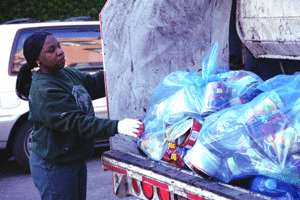
>A Department of Sanitation employee collects used metals, glasses, and plastics. The sale of profitable recyclables helps the department balance its budget.(Courtesy of the New York City Department of Sanitation)
GELLERMAN: It’s Living on Earth. I’m Bruce Gellerman. April 22nd is Earth Day. It's when we commemorate the birth of the modern environmental movement. In recognition, throughout the month of April, Living on Earth is rebroadcasting and updating some of our favorite, award-winning stories from years past.
Today, we begin with a piece from 1995 by producer Joe Richman.
[MUSIC: Dragnet Theme from Television’s Greatest Hits (TVT Records 1986)]
GELLERMAN: The story you are about to hear is true. The names have not been changed to protect the innocent.
[MUSIC UP AND UNDER]
GELLERMAN: Dateline: New York City, where all the news that’s fit to print, is also worth stealing. In the mid 1990’s a nationwide shortage of newsprint sends the price of recycled paper soaring, tempting nefarious criminals interested in yesterday’s news, and not just for reading, if you get my drift.
Our intrepid reporter Joe Richman took to the mean streets and curbs with New York City’s finest: the Sanitation Police, in a story that won a Silver Award from the National Federation of Community Broadcasters.
[POLICE RADIO: "BRAVO AT FOUR LANES WORKING A...; THEY WANT IT CLEAR."
RICHMAN: Officer William Martinez is driving through Manhattan in an unmarked Chevrolet four-by-four with a Greenpeace sticker on the dashboard. He's undercover, sort of, and hot on the trail of a suspect.
MARTINEZ: I'm going up the block; I think I see something up the block, so make a right here.
RICHMAN: Martinez checks in with his partner, who's in another vehicle, and then heads down Second Avenue towards the van he spotted. Martinez stays a half-block or so behind the van, and changes lanes periodically so it won't look like he's following. He thinks there are newspapers in the van, but to make an arrest Martinez must catch the driver in the act: snatching newspaper bundles that are supposed to belong to the city.
MARTINEZ: Timmy is snagged. I'll take those papers.
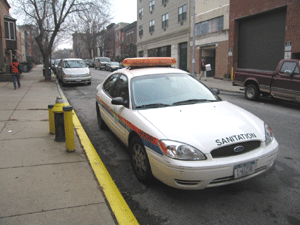
A sanitation police car in New York City. Sanitation officers can fine trash thieves up to $2,000 for taking valuable recyclables like metal and paper. They're city property when they're left on the curb for pickup.(Photo: Adam Kuban)
[POLICE RADIO DIALOGUE]
RICHMAN: The New York Sanitation Police are not your typical cops. All the officers are former trash collectors, and until recently they concentrated mostly on what William Martinez calls sanitary crimes.
MARTINEZ: Littering, uncovered receptacles, dirty sidewalks, obnoxious liquids, which is urinating, unleashed dogs...
RICHMAN: But now, the job has changed. In the last few months, as the value of paper has skyrocketed, Martinez and his partner William Lugo have had their hands full with the paper bandits.
And this night in particular has just become very busy. Officers Martinez and Lugo pull up behind a white van with Virginia license plates. The van is parked next to a pile of bundled newspapers. The driver has been caught red-handed.
MARTINEZ: You do this often?
MAN: No.
MARTINEZ: So, why'd you start tonight? MAN: I came up from Virginia. My friend said they pay good money for paper. He said you can go and take it. I said ‘okay, I'm there.’
MARTINEZ: You just came from Virginia just to do this?
MAN: The guy told me if I fill up a van, he said he gives me like 200 bucks to fill up a van. I said ‘okay, I'm there.’
MARTINEZ: A loaded van, 200 bucks?
MAN: That's what he said. I said ‘I'm there. I'll do three, four a night.’
MARTINEZ: And you just came from Virginia just to do this?
MAN: Yes.
MARTINEZ: All right. Just -
MAN: I'll put the paper back.
MARTINEZ: That's not the point.
MAN: I won't take it.
MARTINEZ: We're going to issue you several summons; we're going to have to just take you down to the precinct just to make sure.
MAN: You're going to arrest me?
MARTINEZ: Park your vehicle.
MAN: For taking the paper?
MARTINEZ: Yeah. It's against the law in New York City to take anything that residents put out on the curbside; it's city property. It belongs to the Sanitation Department. Put your hands together. Okay, follow me.
RICHMAN: It is illegal to take refuse off the street in New York City. Of course, it's a law that until recently was not strictly enforced. In the last few months, Officers Martinez and Lugo have made about one or two arrests a week on average. But this is not an average night. On the way to the police station, Officer Lugo spots another suspicious van and three more paper thieves.
LUGO: Let's see your license and registration or your ID. Put the cigarette down; put the cigarette down, no smoking.
[POLICE RADIO SQUAWKS]
[MARTINEZ SAYS " I HAVE THREE PERPS AND ANOTHER VAN. I HAVE FOUR PERPS OVER THERE AND TWO VANS; I NEED SOME ASSISTANCE."]
[POLICE RADIO SQUAWKS]
RICHMAN: The Sanitation Police aren't pros at collaring criminals the way the NYPD is. And on a busy night things can get a little confusing. Two more sanitation cops arrive on the scene for backup, but there still aren't enough officers to drive all the police cars and the two confiscated vans back to the police precinct. So they have to rely, in this case, on the nearest public radio reporter.
[RICHMAN NARRATES, WHILE DRIVING A POLICE CAR, "RIGHT NOW, I AM DRIVING A POLICE CAR, AND WE'RE GOING UP A ONE-WAY STREET. THAT'S COOL."]
RICHMAN: The whole scene might seem a little silly. Handcuffs, sirens, police backup, all to catch people stealing discarded newspapers. Just a year ago, the city was paying recyclers 25 dollars a ton to take the paper. But now, fetching up to sixty dollars a ton, old newspapers are a source of income. And the Sanitation Department estimates that unless they clamp down on paper thieves, the city could lose up to four million dollars a year.
Of course, enforcement is expensive, too. Right now it might not be worth spending millions on overtime to protect a bunch of old sports sections and New York Times book reviews. But Sanitation Department Commissioner John Doherty says that newspapers and other recyclables are a growing resource for cities like New York: one that is sure to pay off down the road. And Doherty says it's important to send a message now to any would-be street corner entrepreneurs.

A Department of Sanitation employee collects used metals, glasses, and plastics. The sale of profitable recyclables helps the department balance its budget.(Courtesy of the New York City Department of Sanitation)
[PROCESSING OF PERPS AT PRECINCT]
RICHMAN: It's three a.m. by the time Sanitation Officers Martinez and Lugo get to the police station with their paper perps. Most likely, the four offenders will just end up with stiff fines. But, in the meantime, they'll be frisked and held overnight for booking, along with all the evening's drunks and drug dealers. Officer Lugo says he admits to feeling a little sorry for these guys.
LUGO: I know they didn't commit a murder or anything; they just committed petty larceny. If I could make it a little easier for them I'll speak to them nicely. I'm not going to harass them and give them a hard time. I'm going to treat them, you know, like a gentleman. I'm going to treat them the right way. But this is what our job is and this is what I'm going to do.
RICHMAN: As Officer Lugo leads the four paper thieves to a holding cell, a precinct cop looks up and says, "What's this?" Another officer, standing in the corner, says quietly, "You don't want to know." For Living on Earth, I'm Joe Richman in New York.
[POLICEMAN SAYS "GO TO SLEEP. YOU GOT A LONG NIGHT." A CELL DOOR SHUTS; THE KEY TURNS]
GELLERMAN: That was our 1995 award-winning story “The Black Market in Newsprint”. Now, for an update we turn to John Doherty who you heard in the story and is still head of New York City's Department of Sanitation. Commissioner Doherty, thanks for joining me.
DOHERTY: You’re quite welcome, Bruce.
GELLERMAN: So, are the Sanitation Police still patrolling the curbs of New York?
DOHERTY: We haven’t been doing the arrests anymore. We had a little problem with that, but we got that straightened out. Now we have good, solid legislation on the books that allows us to give out a 2,000 dollar fine when we catch somebody stealing either paper or other recyclables from the curb. And we impound their vehicles.
GELLERMAN: Boy, who says grime pays?
DOHERTY: (laughs) Well, a lot of people -- like you heard in the old tape from '95, people didn’t realize what they were doing wrong. At that time, the paper market was really high and there was a good buck to be made out there and that’s what drove these people to go out and take the paper off of the street to make a couple bucks. But then the paper market fell, and it’s a very cyclical market. It has its highs and its lows. And the market right now is high again -- not as high as it was in '95. But the commodity that’s the highest right now is the metal. We recycle plastic, metal and glass in New York City, and a lot of metal is put out at the curb and people are looking to take that these days and they are taking it.
GELLERMAN: So, like zinc, copper—that kind of thing?
DOHERTY: Copper is probably -- has the highest market right now, and when you put a refrigerator or an air conditioner out in the street, there’s copper tubing in there that, at times, some of these people will just rip out the tubing and let the rest of the appliance go. But today, even the regular metal on some of these, even though some of these appliances have a lot of plastic on it, we find that they are taking whole refrigerators and whole washing machines. And they’re just disappearing off the streets on us.
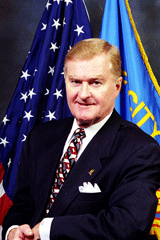
New York Sanitation Commissioner John Doherty says since 1995, metal has replaced paper as the hottest commodity in the recyclables black market. (Courtesy of the New York City Department of Sanitation)
DOHERTY: No, we’re not looking for that. We realize that there, you know, there are homeless people around the city that go by and they lift open the cover on your recycling can and they'll pick out the aluminum cans and bring them to the supermarket and put them in a machine and get their nickels out. So no, no, no, we're not going after them.
And we do know there’s other people, particularly around college areas where young people just, you know, maybe moved into their dorms and they see a nice chair out there and say ‘oh you know, the chair at my desk is kind of broken, let me grab this one.’ No, we don’t bother them. We’re after the people who are making a business out of it.
GELLERMAN: You say you’re not arresting people anymore?
DOHERTY: No, we had to get out of that. The judges kind of frowned on it and we had some legal issues there. But it was only minor. I mean, it suited the purpose at the time. We had to send a very strong signal out to people that we’re not going to tolerate people stealing paper or taking paper from the curb because we have a job to do here and we need that and we get revenue off it. So, we wanted it to stop, so we sent a strong signal by doing the arrests and doing some press clippings and have photographers with us when we'd arrest the guy and put the handcuffs on them.
GELLERMAN: Yeah, I hope you’re recycling your press clippings.
DOHERTY: Oh, definitely.
GELLERMAN: Well, Commissioner, it’s been a great pleasure. I want to thank you very much.
DOHERTY: Okay, Bruce. Thank you.
GELLERMAN: John Doherty is the Commissioner of the Department of Sanitation for the City of New York.
[MUSIC: Dragnet Theme from Television’s Greatest Hits (TVT Records 1986)]
Related link:
New York City’s Department of Sanitation
[MUSIC: Various Artists “Windmills Of My Mind” from Irma Chill Out Café Volume Otto Part 2 (Irma Records 2007)]
GELLERMAN: You can hear our program anytime on our website or get a download for your mp3 player. The address is LOE dot org -- that's L-O-E dot O-R-G. And you can reach us at comments at LOE dot org, once again comments at L-O-E dot O-R-G. Our postal address is 20 Holland St., Somerville, Massachusetts 02144, and you can call our listener line at 800-218-9988. That's 800-218 99 88.
GELLERMAN: Just ahead, searching for seeds of the ice age in the bottom of ancient lakes.
COLINVAUX: You can get 100,000 pollen grains in a cubic centimeter of lake mud. It’s a time machine. I go around calling it my time machine. Have time machine, will travel. That’s my motto.
GELLERMAN: Forty years of traveling back in time. Keep listening to Living on Earth!
Amazon Expeditions
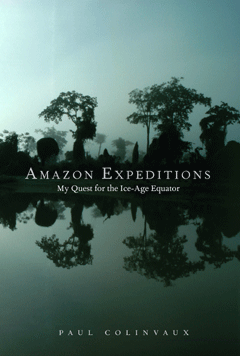
GELLERMAN: Why are areas by the equator so richly diverse in wildlife, when places in northern climes are so species poor? Well, ecologist Paul Colinvaux spent forty years investigating that question, analyzing core samples of sediment from ancient lakes for clues.
COLINVAUX: Pollen analysis in the Amazon was harder even than finding the ancient lakes. There are 80,000 species of plants known in the Amazon -- 80,000 kinds of pollen.
GELLERMAN: Paul Colinvaux’s search for signs of climate change are chronicled in his new book, “Amazon Expeditions; My Quest for the Ice Age Equator.” It’s sort of Linnaeus meets Indiana Jones. I asked Colinvaux why anyone would spend decades trekking along the equator in search of ancient lakes.
COLINVAUX: Well, my first and original reason is that it might help us understand why there are so many species there. The first, and in those days, still living hypothesis to explain this was that the Ice Ages did it by extincting everything in the North and the equator escaped and it was nice and warm and everything went on as usual and been gathering species forever, but we didn’t know what it was like at the equator in the Ice Age, we just thought it was.
GELLERMAN: Not until you go there. Now, there was something called the Haffer Hypothesis.
COLINVAUX: Yes.
GELLERMAN: Did I pronounce that correctly?
COLINVAUX: That’s correct.
GELLERMAN: So, his hypothesis says that things dried out and that grasses populated the area.
COLINVAUX: Savannas.
GELLERMAN: And that led to the speciation, the evolution of different species.
COLINVAUX: Yes, because there were little patches of forest left where, by some curious accident, he never explained that, the rain kept going and they were an archipelago of refugia.
GELLERMAN: And you found that, over your forty years, that, in fact, not true.
COLINVAUX: Not true.
GELLERMAN: No grasses.
COLINVAUX: No grasses.
GELLERMAN: And the way you did that is by doing these core samples in ancient lakes, looking for pollen.
COLINVAUX: That is correct, looking for pollen because once you’ve got the pollen and a date…I had to get a date of 20,000 years, for instance, because that was the height of the Ice Age, well that’s easy, you do it with radiocarbon. So you say, ‘This bit of mud is Ice Age mud’ and you can extract the pollen from it and the pollen grains are perfectly preserved. You can get 100,000 pollen grains in a cubic centimeter of lake mud. It’s a time machine. I go around calling it my time machine. “Have time machine, will travel,” and that’s my motto. And when the Haffer hypothesis came out, that was perfect for “have time machine, will travel,” because as a hypothesis it was beautiful. It predicted something testable. It said that if you had a time machine and you went to the Amazon in the Ice Ages with your time machine, you would find savanna and no forest. Well, I had a time machine that would do just that but it’s pollen in lake mud. And I did just that and bingo!
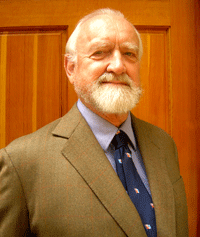
Paul Colinvaux. (Photo: Mark Chester)
COLINVAUX: Yes.
GELLERMAN: How do you find an ancient lake? You would think that people would know those.
COLINVAUX: Well, I did it the hard way. In fact, I have a conceit that this was the last of the old time explorers. Now you do it with Google Earth and things like that, and GPS systems and -- I did it by talking to the locals, getting air photos from the military whenever they’d done it, which was not, wasn't all that often. But then you’ve got to get to them and you can’t really know just by looking at them, but I quickly developed a criterium: they must be above rivers.
GELLERMAN: Why is that?
COLINVAUX: Because then the river has never come in and swashed them out.
GELLERMAN: You went to the Galapagos.
COLINVAUX: I went to the Galapagos.
GELLERMAN: 1960...66 I think.
COLINVAUX: 1966. And this was before tourism.
GELLERMAN: You discovered an ancient lake.
COLINVAUX: Yes, which was unknown to geography, and it’s a beautiful fresh water lake. I did the chemistry of its water, it’s the same as rainwater. Just lovely, you can drink it straight up. And it’s sitting on top of a mountain, under permanent cloud.
GELLERMAN: In the Galapagos, you also discovered a plant.
COLINVAUX: Oh, yes.
GELLERMAN: It’s named after you.
COLINVAUX: Passionflora Colinvauxiae. Yes, it’s one that Darwin missed.
GELLERMAN: I think it’s very interesting that it’s a passion flower, because you’re a passionate man.
COLINVAUX: Well, that’s kind, yes.
GELLERMAN: But I’m saying, how many other people do you know, who would spend forty years trekking through the equatorial regions in search of ancient lakes and pollen from an Ice Age?
COLINVAUX: There aren’t any.
GELLERMAN: Your work shows that the core samples that you’ve collected over these many years don’t show an increase in grass pollen during the Ice Age.
COLINVAUX: Correct.
GELLERMAN: So now, after the end of a 40-year career investigating this, trekking through thick and thin, aren’t you a little, well, disappointed that you don’t have an answer to replace this hypothesis?
COLINVAUX: Well, I would like to have another 40 years. I rather suspect the good God’s not going to give it to me. Perhaps because I’m an atheist like most biologists with sense.
GELLERMAN: Well, professor, thank you for coming by. I really appreciate it.
COLINVAUX: Thank you.
GELLERMAN: Paul Colinvaux is senior research scientist at Marine Biological Laboratory at Woods Hole, and professor emeritus at the Ohio State University. His new book is called "Amazon Expeditions: My Quest for the Ice Age Equator."
[MUSIC: Azymuth “Blauzinho Carioca” from Brazilian Soul (Far Out Records 2004)]
GELLERMAN: On the next Living on Earth. emergency room doctors in Alaska are on alert as global warming creates a hospitable climate for harmful insects.
DEMAIN: We experienced our first two deaths in Alaska from yellow jacket stings in 2006 and when we started looking at this we found that there was about a ten-fold increase in the number of yellow jackets in Fairbanks.
GELLERMAN: Insects, allergies and climate change, next time on Living on Earth.
GELLERMAN: Living on Earth is produced by the World Media Foundation. Our crew includes Ashley Ahearn, Bobby Bascomb, Eileen Bolinsky, Ingrid Lobet, Helen Palmer, Mitra Taj and Jeff Young, with help from Jennifer Baessler, and Sarah Calkins.
Our interns are Annie Jia and Margaret Rossano. Jeff Turton is our technical director. Alison Lirish Dean composed our themes. Steve Curwood is our executive producer. You can find us at LOE dot org. I’m Bruce Gellerman. Thanks for listening.
ANNOUNCER1: Funding for Living on Earth comes from the National Science Foundation, supporting coverage of emerging science, and Stonyfield Farm -- organic yogurt and smoothies. Stonyfield pays its farmers not to use artificial growth hormones on their cows. Details at stonyfield.com. Support also comes from you our listeners, the Ford Foundation, the Town Creek Foundation, the Oak Foundation, supporting coverage of climate change and marine issues, and Pax World Mutual Funds: socially and environmentally sustainable investing. Pax World: for tomorrow. On the web at paxworld.com.
ANNOUNCER2: PRI, Public Radio International.
Living on Earth wants to hear from you!
Living on Earth
62 Calef Highway, Suite 212
Lee, NH 03861
Telephone: 617-287-4121
E-mail: comments@loe.org
Newsletter [Click here]
Donate to Living on Earth!
Living on Earth is an independent media program and relies entirely on contributions from listeners and institutions supporting public service. Please donate now to preserve an independent environmental voice.
NewsletterLiving on Earth offers a weekly delivery of the show's rundown to your mailbox. Sign up for our newsletter today!
 Sailors For The Sea: Be the change you want to sea.
Sailors For The Sea: Be the change you want to sea.
 The Grantham Foundation for the Protection of the Environment: Committed to protecting and improving the health of the global environment.
The Grantham Foundation for the Protection of the Environment: Committed to protecting and improving the health of the global environment.
 Contribute to Living on Earth and receive, as our gift to you, an archival print of one of Mark Seth Lender's extraordinary wildlife photographs. Follow the link to see Mark's current collection of photographs.
Contribute to Living on Earth and receive, as our gift to you, an archival print of one of Mark Seth Lender's extraordinary wildlife photographs. Follow the link to see Mark's current collection of photographs.
 Buy a signed copy of Mark Seth Lender's book Smeagull the Seagull & support Living on Earth
Buy a signed copy of Mark Seth Lender's book Smeagull the Seagull & support Living on Earth

